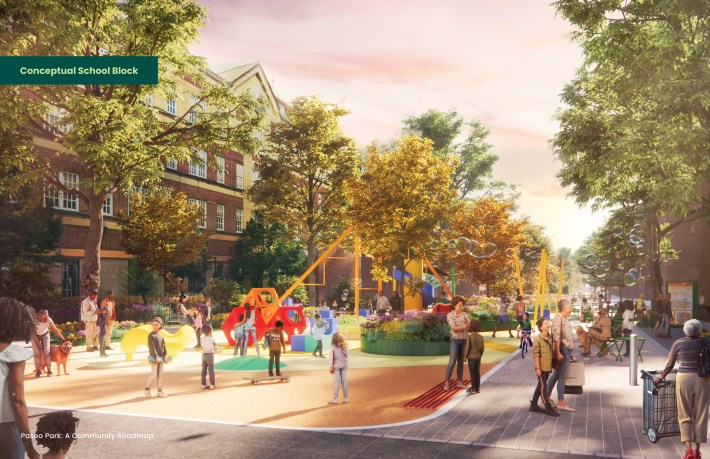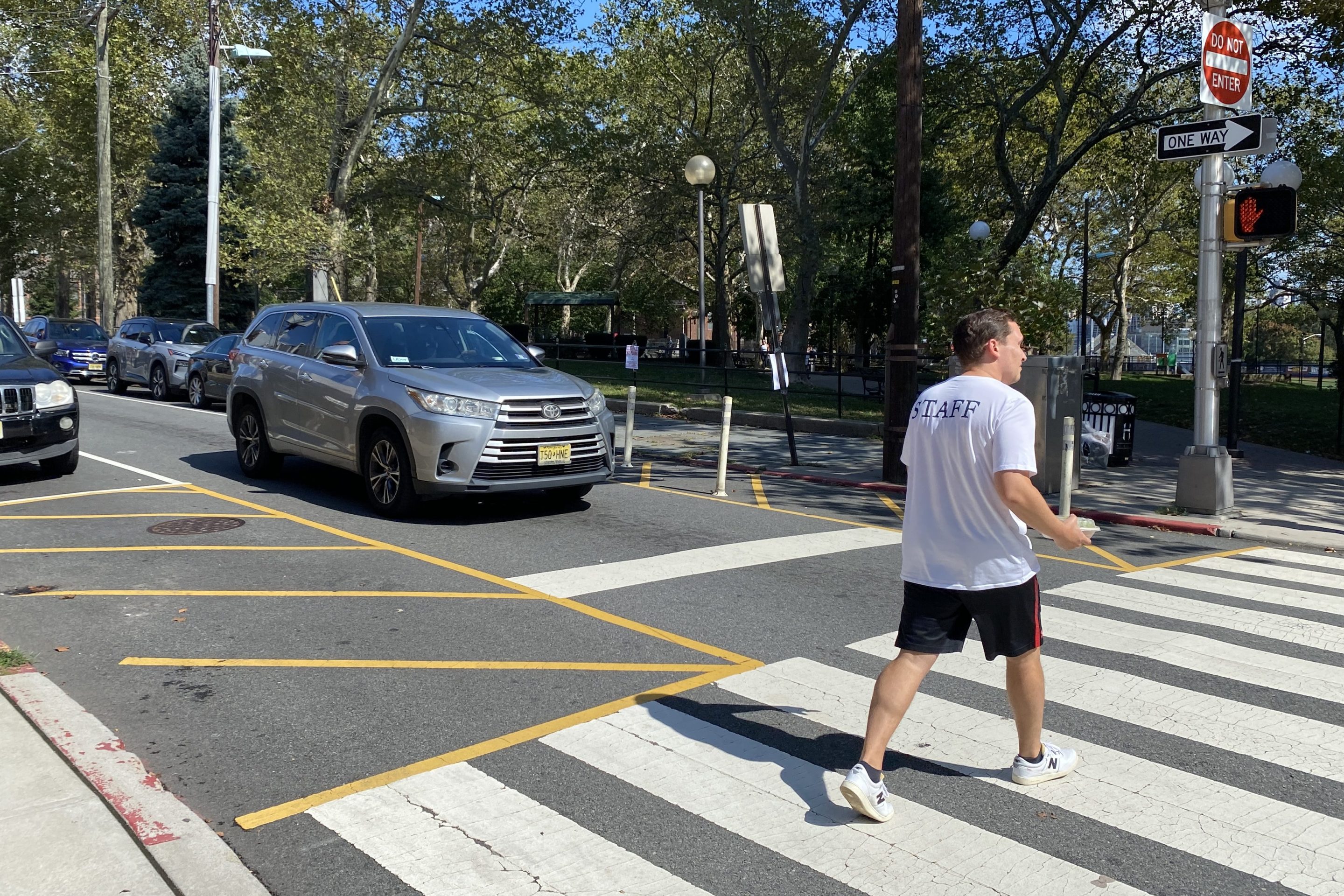New York City’s most popular car-free street has a moped problem — but supporters hope design changes can help calm the street and redirect faster micro-mobility users to busier streets.
The 26-block 34th Avenue open street in Jackson Heights is widely recognized as the “gold standard” for the city’s car-free open streets. Yet there are some gripes even from its fans — chiefly the presence of moped riders along the mostly traffic free stretch, violating the posted 5-mile-per-hour speed limit.
As the city Department of Transportation plans for an $89-million redesign, the Alliance for Paseo Park brought in architecture firm WXY to produce a roadmap to turn the 1.3-mile stretch into a permanent linear park.
Chief among the firm’s recommendations: a micromobility lane on nearby Northern Boulevard to give delivery workers and commuters on e-bikes a more direct route without relying on 34th Avenue.
And repurpose the 273 remaining parking spots that line 34th Avenue — or 3.6 percent of the street parking in Jackson Heights — for more park space.
“We can design a delightful park space for the community that quadruples our park space,” Dawn Siff, executive director of the Alliance for Paseo Park, told Streetsblog. “People want an uninterrupted, pedestrian-first space.”
The open street was created in the early days of the COVID-19 pandemic, when Jackson Heights and nearby Elmhurst and Corona were the epicenter of the citywide health crisis.
The neighborhood has only one small park, Travers Park, for a densely packed area that’s home to immigrants from all around the world. More affluent residents often have access to private gardens at their co-op buildings, but poorer residents are shut out.
Since its creation, 34th Avenue has undergone several rounds of construction. On most of the street, local traffic is still allowed, though cars must yield to pedestrians and obey the 5 mph speed limit. But several “plaza blocks” have been added where car traffic is banned altogether and tables and chairs are put out.
Currently, DOT is in the process of relocating bike lanes which on some blocks have run down the middle of the street, to instead run along the curb. The change is a response to community feedback and hopes to create clearer routes for cyclists and more contiguous space for pedestrians, according to DOT.
Complaints about mopeds, which are banned from the stretch but are commonly on it anyway, prompted local Council Member Shekar Krishnan to hold a “moped crisis” town hall last year and blast the previous center-running bike lane design.
The WXY report recommends going a step further, and creating a new lane on Northern Boulevard to divert moped and faster bike traffic.
One option would be creating a wide multimodal bus, bike, and moped lane running down the middle of Northern Boulevard. That type of configuration has been used in Chicago and Paris, though not in New York, the authors said.
Another option would be separate protected bike lanes along both sides of Northern Boulevard, in addition to the existing bus lane.

Delivery worker hubs and charging stations could be placed along Northern Boulevard to further nudge delivery workers to take it instead of 34th Avenue.
The roadmap envisions dividing the linear park into three types of blocks — active blocks for recreation and exercise, passive blocks for quiet recreation and rest, and school blocks outside the seven schools along the avenue which would offer outdoor learning and play space.

“Paseo Park lacks a streamlined consistent design layout. On some streets there are still parked cars, while vehicles park in places that are prohibited, such as plaza blocks. Bike lanes are not continuous or predictable, part of efforts to slow down cyclists and discourage mopeds and motorcycles. There is little clarity of rules and limited places for specific types of vehicles, leading to large delivery trucks parking in crosswalks,” the authors say of the current setup.
They call for widening the medians and raising the street bed to make it even with the sidewalk. Renderings show more greenery and gardens, additional seating, and play and exercise equipment.
“We’re thinking of vehicles as the guest in the space, but really thinking of this predominantly as park land space,” said Rob Daurio, the director of urban sustainability at WYX.
Drivers would still be allowed to access garages for apartment buildings along the avenue, as well as drop off passengers and make deliveries.
The report suggests retractable bollards, which could be lowered using a remote control, to replace the metal barriers that are currently put out each day. That would address one of the most common complaints about the open street, that the barriers are too difficult to move for residents with disabilities.
Those complaints were seized on in an Americans With Disabilities Act lawsuit seeking to shutter 34th Ave. and other open streets, though that complaint strayed from its focus on disability access to liken anti-car activists to Nazi “brown shirts.”
A small but dedicated band of opponents has railed against the open street, describing it as a “prison environment” that “looks like 1961 Berlin” and demanding, “When will the gluttony end?”
But pedestrian injuries fell 41 percent after the creation of the open street. Dance classes, chess clubs, English lessons, food giveaways and relay races are regularly held along the street, hosted by the 34th Avenue Open Streets Coalition, which partners with DOT to manage the space.
Coalition co-founder Jim Burke said he welcomes ideas for the future of the street, but wants to make sure bike access is maintained.
“You see so many senior citizens and so many children and so many kids riding their bicycles,” he said. “I really want to make sure people can use our corridor to go back and forth to their jobs, ride with their families.”
He said concerns about mopeds are “overblown,” and people who participate in programs on the street are more bothered by encroaching cars. “That’s our number one concern, are cars not respecting our car-free spaces,” he said.
The WXY designers said they envisioned Paseo Park as a shared space where slow-moving bikes would be welcome.
The ideas in the report emerged from a year-long series of outreach sessions and workshops in the neighborhood, along with a survey designed by local Girl Scouts for kids to give their input.
In the upcoming mayoral primary, all the Democratic contenders have committed to keeping and expanding the open streets program with the exception of former Gov. Andrew Cuomo, who has said he’ll take it case by case.
“Cities around the world are figuring out how to turn street space into delightful green public spaces that make their communities healthier and safeguard against the effects of climate change. New York City is behind,” Siff said. “This could be a legacy project for the next mayor.”
A spokesman for city DOT praised the WXY report.
“We will consider these great ideas when we go back later this year to get community input for the future capital reconstruction of 34th Avenue,” spokesman Vin Barone said in a statement.
“The corridor is also an important part of NYC DOT’s cycling network and part of our long-term vision will support the various cycling uses — commuter, delivery and social — on 34th Avenue.”






